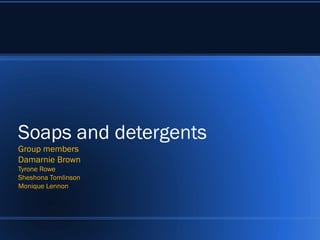Soaps and detergents
- 1. Soaps and detergents Group members Damarnie Brown Tyrone Rowe Sheshona Tomlinson Monique Lennon
- 2. What is a Soap? ï A soap is compound of alkali and fat, used with water as a cleaning agent.
- 3. What is it made of? ï Saponification is the process by which soap is made. Soaps are made from the alkaline of natural esters as fats and oils. These esters are made from large carboxylic acid molecules containing more than ten carbon atoms in their hydrocarbon chains, and glycerol - an alcohol containing 3 OH groups in its molecule.
- 4. Advantages of the soap ï Soaps are cheap. ï Can be manufactured from renewable sources ï Donât cause skin allergies. ï Soaps are biodegradable and so will not perish in the environment.
- 5. Disadvantages of the soap ï They do not remove all types of dirt. ï They donât clean very efficiently in hard water. Hard water contains calcium and magnesium ions that react with the soap to form insoluble salts called scum. ï They form gels which clog sewerage systems.
- 6. Detergent s
- 7. What is a detergent? ï A detergent is a cleaning agent. There are two types of detergents: soapy detergent [made from the hydrolysis of natural esters] and the soapless detergent.
- 8. What is it made of? ï In general detergents are made from hydrocarbon products which react with highly concentrated sulphuric acid to convert them to an organic acid based on the âSO3H group.
- 9. Soapy AND SOAPLESS DETERGENTS ï Soapless Detergents ï Soapy Detergents ï Made from petroleum ï Soapy detergents are made from reacting natural esters products that have been with an alkali. treated with concentrated sulphuric ï Usually comes in the acid. form of bars and is biodegradable. ï Most are non- biodegradable and ï It is converted to scum when used with hard water. comes in the liquid form.
- 10. What is found in a detergent? ï Detergents does not contain 100% active detergent ingredients. ï Detergents usually contains 20% surfactant which is the active cleaning ingredient. 30% phosphates which is added to soften hard water. 40% sodium sulphate for keeping it dry and10% bleaching agents and optical brighteners.
- 11. Advantages of the detergent ï They are very cheap. ï There is no wastage when using hard water since detergents doesnât form scum.
- 12. Disadvantages of the detergent ï It is non- biodegradable which means that it is resistant to bacterial breakdown and if it ends up in rivers or lakes cause foaming. ï Prone to extensive algal growth due to the high phosphate content which provides nutrients for the algal.
- 13. dB ye! G oo






![What is a detergent?
ï A detergent is a cleaning agent. There are two
types of detergents: soapy detergent [made from
the hydrolysis of natural esters] and the soapless
detergent.](https://image.slidesharecdn.com/soapsanddetergents-130128120515-phpapp02/85/Soaps-and-detergents-7-320.jpg)





